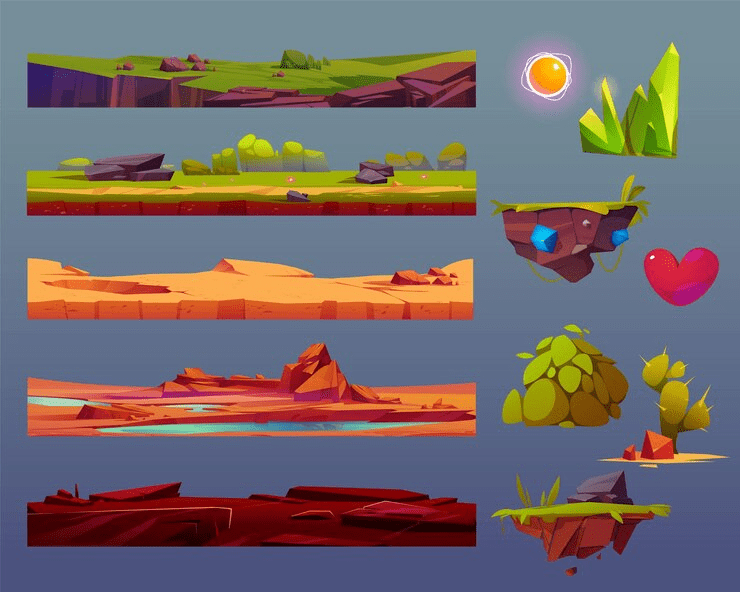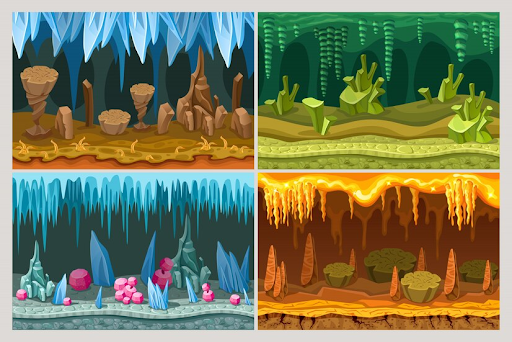
The special quality of visual arts is that they are able to immediately put you in the mood, transmit emotions and tell an entire story in a single still image. 2D art is different than literature or film in that it is able to capture an entire moment and atmosphere in one frame. If visual artists use the full potential of their medium, they can be incredibly efficient storytellers.
When built properly, the visuals of a 2D work of art can easily send the viewer to another world. Combining that all together gives an artist a compelling atmosphere to paint — basically the backdrop to their narrative — while simultaneously establishing a mood with lighting, color palette, setting, character, poses, and so on.
In this article, we will discuss the most important atmospheric elements of 2D art and how artists utilize them to craft impactful visual storytelling. Understanding these core building blocks will help enrich your appreciation of 2D art across all mediums. For those seeking professional assistance, 2D art services can be an invaluable resource, offering expertise to elevate visual narratives. This article also provides practical guidance for artists looking to improve their storytelling techniques.
The Importance of Lighting
Lighting is one of the most fundamental ways to establish an atmosphere or mood in 2D art. The intensity, directionality, and color of lights dramatically alter the feeling of an artwork. It’s one of the fastest ways to signal to the viewer whether a scene is meant to be comforting, ominous, intense or melancholy.
Side lighting typically creates a more dramatic atmosphere than front or backlighting. It defines shapes with strong contrasts between highlights and shadows. Scenes lit from the front, on the other hand, come across as more flat and benign. Lighting from behind a subject often gives them an ethereal, halo-like glow. It silhouettes details to create a sense of mystery and visual intrigue.
The color of light sources also matters tremendously. Warm, yellow lights make a setting feel welcoming and homey, while cool blue or green lights read as unnatural and eerie. Combining colors of different temperatures can suggest mixed or conflicting emotions.
When designing 2D scenes, artists put a lot of thought into the lighting. Even something as basic as the position of a light source's reflection in a character's eyes impacts the atmosphere tremendously.
Composition and Framing
What the artist selects to include or exclude in the frame is determined by the narrative focus. The relative sizes of the elements, as well as their positioning, subconsciously imply the emotional interpretation of the viewer.
Dead space in compositions can really make scenes feel sparse, lonely or just generally lacking in action. This pictures things very close to the frame, and cropping elements out the sides of the image makes things feel more intense and claustrophobic. The impression of adventure and wondrousness is generated by compositions of strong diagonals or steep verticals. Horizontal compositions work best when they are completely horizontal.
Impacting atmospheres are considered by all these compositional implications when artists craft them. Let’s take this as an example of this case: If they wanted to show something as chaotic, they would use a composition with very strong diagonals and close cropping to make everything fall off a bit.
Color Palette Selection
The colors used in 2D art have an emotional resonance independent of the actual objects depicted. Certain hues and color combinations simply read as more melancholy, cheerful, ominous or nostalgic than others. Artists carefully curate their color palettes to reinforce the intended atmosphere.
For example, golden yellows, bright oranges and cyans tend to feel joyful and uplifting. Dark blues, deep burgundies and hunter greens suggest gloominess or mystery. Neutral grayscale pieces have a sober, dramatic effect. Complementary color schemes like violet and yellow or red and green pop visually to add vibrancy.
In addition to hue choices, the saturation and value contrast within a palette impact the atmosphere. Very saturated palettes feel more intense and dynamic. Desaturated or mostly monochromatic palettes have a more subtle, gloomy effect. Strong value contrasts add excitement, while predominantly mid-tone scenes feel misty and contemplative.
The colors don’t need to be realistic either to set the right mood. In fact, overly vibrant and unnaturally colored scenes are common in 2D gaming concept art to bring more atmosphere and fantasy to the environments. The goal with color is to paint emotions, not necessarily real-life accuracy.
Character Design and Body Language
Characters in visual storytelling are well crafted. The characters look through the stories, so viewers look vicariously. Pose, expression, and appearance help tell narrative events and establish the overall atmosphere.
Without explicitly representing a backstory, character outfits, hairstyles, weapons and accessories hint that they have one. Military maidens are always dressed immaculately, but weathered adventurers will always be dressed in a ragged cloak. Shapes and silhouettes of outfits also fit the environment we are trying to create. Elegant flow gowns versus aggressive angles and armor, respectively.
It sets the baseline mood and how a specific story beat makes someone react. Crouches for combat-ready scenes create tension instantly, while relaxed postures help make scenes feel safe and content. Very anguished, shocked or overjoyed faces of the characters will quickly transmit those emotions to the viewer.
They even provide viewers clues to where they should look across scenes. Artists intentionally have their subjects making eye contact with key objects or off into the distance to raise the question of what’s going on off the frame.
Settings and Backdrops
The environments and scenery surrounding characters provide crucial visual context for stories. The geography, architectural styles, weather and small decorative accents all work together to immerse viewers in another world crafted by the artist. These settings establish whether stories take place in bustling cities, abandoned wastelands, realist domestic scenes or fantastical alien planets.
Some examples of backdrops that immediately flavor scenes with atmosphere include:
Castles and medieval villages. Instantly evoke adventure and stories of knights, wizards and mythical beasts.
Futuristic cityscapes. Put viewers in dystopian sci-fi scenarios involving high technology, like spaceships and robots.
Foreoding forests and mountains. Establish a dark fairy tale atmosphere with magical creatures and witches' bars.
Tropical beaches and coastlines. Feel relaxed and carefree with opportunities for oceanic exploration.
The details really bring these settings to life. Subtle touches like flickering candles, cluttered desks, alien flora and fauna and weather effects build a strong sense of immersion in another reality. This transports viewers’ imaginations, allowing the artist to tell more impactful stories within their crafted atmosphere.

Textures and Surface Qualities
The textures and finishes of materials in 2D art also influence the mood tremendously. Pieces with very smooth, blended colors and soft edges feel more dreamlike compared to rougher, grittier styles. The textures lend physicality and a sense of place to people and objects in the scene.
In hand-drawn and painted works, the canvas texture even impacts the atmosphere. Very smooth papers and illustration boards make cleaner, crisper images. Rough watercolor paper allows for natural graininess and happy accidents of pigments pooling organically in the pits and valleys. This adds an aged, timeworn quality that complements some atmospheres.
The thickness and opacity of lines also change the mood. Clean lines feel more orderly and structured, while sketchy, wavering lines have energy and suggest things in motion. Very thin lines practically disappear to make scenes feel more ethereal. Thick outlines flatten forms to give a simplified, graphic look.
The surface qualities alone convey different atmospheric flavors before considering the content of the image. Even if their compositions were identical, a painting made with messy textures, drips, and scratches feels much darker and grittier than another with clean, blended colors and gradients. The textures help set expectations for the story’s atmosphere.
Level of Realism
Realism with 2D art styles varies greatly from super realistic representations to the most completely abstracted shapes and colors. The story and atmosphere have to have a certain amount of real-world grounding in order for artists to choose where to land on this spectrum.
Two nature landscape paintings are compared to further illustrate how realism affects the mood and the story telling. Photorealistic painting is more concerned with capturing certain details specific to the place and time, such as foliage shapes and light effects. That keeps viewers in reality, so the story beats feel as real as real things.
A simplified, cartoony landscape, by contrast, has more freedom to bend reality for imaginative world-building. Trees might be blue, and clouds might be cubes. This transports viewers out of reality into a more magical, whimsical headspace. The viewer is less concerned with factual accuracy than enjoying the strange new world the artist invented.
Special Effects and Dynamic Elements
So far, this article has been focused on the atmosphere-defining components of static 2D art. However, while many of these mediums do allow artists to create semi-dynamic effects, they take their visuals further than ever before. Elements such as flickering flames, drifting smoke, rippling water, and moving light sources in the right doses can take an atmosphere and make it dramatically better.
For digital art, these effects are simple to add if not added to animation and video editing software. Works that are hand-drawn and painted rely less on actual motion and more on implied motion through clever compositions, textures and lines. While the impact on the atmosphere is just as powerful, the impact on the atmosphere remains just as powerful.
When looking at 2D art, look for things that imply this is a living, breathing world behind the image. In particular, fire, water and weather effects, organic in the best sense, bring landscapes to life. Figure portray such that subtle motions on characters give of more active and intense atmosphere than absolutely not characters.
Conclusion
The size of the 2D game market was estimated at USD 10.3 million in 2023 and is expected to expand at a compound annual growth rate (CAGR) of 10.5% from 2024 to 2030, reaching USD 20.7 million. These numbers speak to the popularity of such games and the importance of developing artists and animators.
2D artists are masters of every pixel and brushstroke in their work. They can fine-tune each atmospheric element that is discussed in order to create their own unique creative vision. Before they even start to write any narrative, they spend enormous thought into lighting, textures, color palettes and character poses to set the perfect mood.


